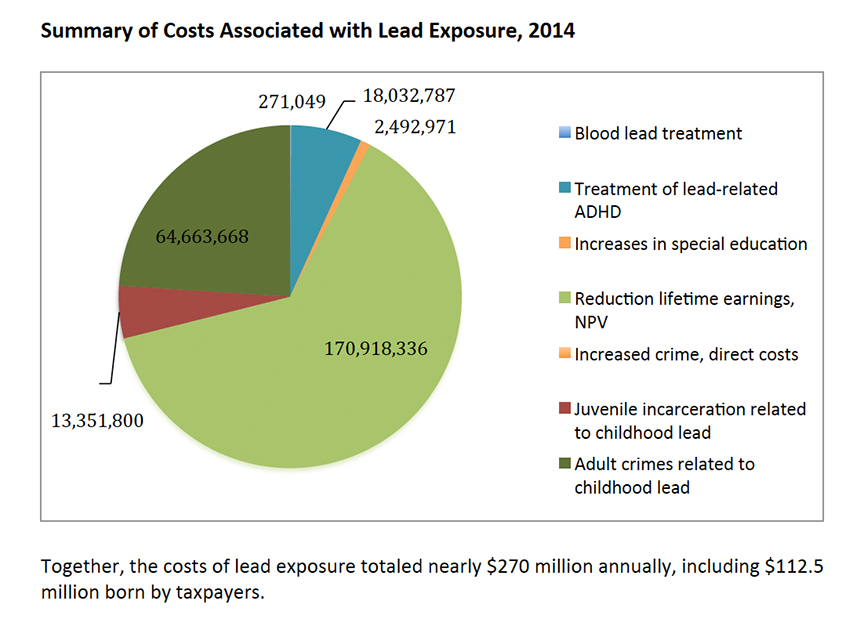
Group Calls on State Policymakers to End Lead Poisoning in Michigan
Based on the findings of an updated report released today, a coalition of health and environmental groups is calling on Michigan policymakers to end lead poisoning in Michigan. The study found lead abatement is a sound economic investment and a critical public health step for Michigan’s future. Michigan was the fifth worst in the nation for the rate of childhood lead poisoning by the CDC in 2013. Lead poisoning of children costs Michigan at least $270 million per year. The study is an update to the Economic Impact of Lead Exposure and Remediation in Michigan released in 2014, and the Price of Pollution report published in 2010.
“Now is the time to elevate lead poisoning of Michigan’s children to the critical public health problem that it is,” said Rebecca Meuninck, deputy director of the Ecology Center. “In 2014 we still had communities with nearly 20% of tested children have high levels of lead in their blood. Michigan policymakers should not rest when there are cost-effective solutions for an entirely preventable problem.”
Costs of Lead Exposure and Remediation: Update, authored by Tracy Swinburn for the Ecology Center is an update to our earlier report that compared the costs of lead contamination of children with the cost to prevent the problem. Four categories of impact were studied: increased health care, increased adult and juvenile crime, increased need for special education, and decline in lifetime earnings. Overall, the annual cost of lead exposure in Michigan children is approximately $270 million, $112 million of which is paid by taxpayers. The current report uses 2014 data, the most recent complete data set available from the State of Michigan.
More that half of the total cost comes from a loss of lifetime earnings ($171 million), followed by an increase in juvenile and adult crimes due to lead poisoning (over $77 million), increased healthcare costs ($18 million), and costs of special education ($2.5 million) attributed to lead poisoning.

“Lead exposure results in significant costs borne by Michiganders, including incarceration, special education, and loss of earnings,” said Tracy Swinburn, economist, and author of the report. “Investments in remediation have both public health and economic benefits.”
The Flint water crisis has renewed attention on the critical issue of lead poisoning of children. The catastrophic events resulted in the entire community being exposed to lead through the municipal water system. While that crisis is ongoing, the state has taken action to reduce lead levels in Flint and has proposed important policy changes to address the issue of lead in water. The cost of remediating lead in municipal water is beyond the scope of this report.
The study only addresses the costs of remediation for lead paint and dust hazards in homes, which is estimated to be responsible for 70% of lead exposures in lead poisoned children. The study does not address remediation costs associated with lead in water, nor does it address the costs of the current Flint water crisis. The report estimates that the costs of remediation for lead paint of all most-at-risk homes to be $600 million.
On June 10th, the Snyder Administration empaneled the Child Lead Poisoning Elimination Board to develop a long-term, statewide strategy to help prevent some of Michigan’s most vulnerable residents from being exposed to lead from all sources. The 12-member board includes experts in the prevention and mitigation of child lead poisoning, and representatives from pediatric hospitals, local government, education, nonprofit and health agencies.
“Our state’s goal and the goal of the Child Lead Poisoning Elimination Board must be nothing short of being the first state to end lead exposure in all of our children,” said Dr. Mona Hanna-Attisha, pediatrician, and director of Hurley and MSU’s Pediatric Public Health Initiative. “With lead exposure as one of the most significant and preventable environmental health hazards for Michigan children, it is our ethical and economic imperative to invest in Michigan’s future.”
As cited in the report, 21.1% of ADHD cases have been associated with elevated blood lead levels. 15% of adult crime has been associated with lead exposure and 10% of juvenile delinquency.
Over 1.3 million homes in Michigan were built before 1978 and are likely to contain lead paint. Lead paint and dust are estimated to be at the root of 70% of lead exposure. The study predicts that if the 100,000 most at-risk homes in Michigan were targeted for lead-abatement it would cost the state approximately $600 million. As a result, lead exposure and its associated costs are estimated to be reduced by 70%. This public health investment would return nearly $190 million annually to Michiganders, $78 million of which is cost savings to Michigan taxpayers. Effectively, remediation is estimated to pay for itself in 3 years and repay taxpayer investment in about 7-8 years.
“Our analysis indicates that remediating lead is a strong economic investment for the State. Our coalition calls on the Michigan Legislature and candidates running for office to embrace the Governor’s commitment to end lead poisoning in Michigan and implement forthcoming policies recommended by the Child Lead Poisoning Elimination Board,” said Joyce Stein, retired neonatal nurse and member of the Michigan Network for Children’s Environmental Health.

